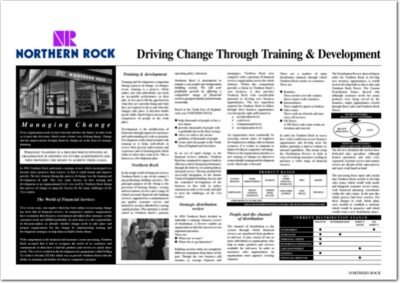Parcelforce Worldwide is part of the Royal Mail Group Ltd. Royal Mail Group has three main operating brands:
- The Post Office Ltd provides counter services to the high street customer
- Royal Mail manages the delivery of letters and packets
- Parcelforce Worldwide provides express parcel delivery services for businesses and consumers
Parcelforce Worldwide has over 30,000 business customers in the UK. It handles 200,000 parcels a day. It has a turnover of £382 million. In 2006-07, revenues grew by 7.3% over the previous year. With its 23 partners across 30 European countries and access to Postal Administrations through the Universal Postal Union. It operates:
- Business to Business (B2B) services, delivering parcels and supplies from companies to other companies
- Business to Consumer (B2C) services, delivering parcels to individuals in their homes around the UK
Parcelforce Worldwide competes in a free or unregulated market. A free market is open to all. Any company can choose to operate in the market and customers can choose any supplier they wish. Suppliers therefore need to provide good value for money to keep customers and win new business.
The need for change
In 2002, Parcelforce Worldwide was making a loss. In response, those managing the business decided to change the type of service it offered. Instead of unguaranteed parcel deliveries typically taking between two and four days, Parcelforce Worldwide decided to focus on time and day guaranteed, express delivery. This resulted in a reduction of the number of parcels handled (volume) but increased the value of each delivery to Parcelforce Worldwide.
As a result of these changes, Parcelforce Worldwide also increased operational efficiency. The business:
- reduced the number of staff it employed
- closed some of its depots
- opened a new, technologically advanced sorting centre in Coventry

These changes enabled Parcelforce Worldwide to achieve its financial targets. It turned a loss-making business into a profitable one. However, it recognised that more could be done to improve efficiency. The business sought to improve staff attendance rates. It wanted to cut absenteeism staff taking unauthorised or sick leave and reduce the time lost as a result of accidents at work. To do this, Parcelforce Worldwide introduced a more decentralised approach to management. This gives depot managers greater decision-making accountability to improve the effectiveness of the operation in their local area.
Differentiation
Most companies operating in the express parcel delivery market offer similar services. Parcelforce Worldwide remains competitive by differentiating itself in other ways. Parcelforce Worldwide has developed a unique selling proposition (USP) based on high-quality customer service.
This customer-orientated approach is designed to attract and retain key customers. Parcelforce Worldwide works in partnership with customers, such as the UK’s examination boards, to develop and deliver services to meet specific needs. During exam season, Parcelforce Worldwide delivers millions of exam papers, scripts and coursework.
This case study examines how a strategy focused on customer service can contribute to longterm business development.
Business strategy
Businesses have aims and objectives. Aims are the long-term targets of the business. Objectives are the steps that help to achieve these aims. Objectives should always be SMART that is, they should be specific, measurable, achievable, relevant and set within a timeframe. This enables a business to assess what the objectives contribute to its overall aims and when they will be achieved. Businesses may set objectives to:
- make the most of something for instance, a business may want to increase growth, sales, profit and customer satisfaction
- reduce something adverse or unwelcome for example, limit risk or reduce staff absence
- change the image or culture of the business for example, changing the focus on internal operational issues from speed of service to a focus on customers needs
Business strategies

These objectives help to inform business strategies. By carrying out a SWOT analysis, a business can identify the best strategies to pursue. These strategies focus on different aspects of the business. For example, Parcelforce Worldwide has:
- operational strategies to improve its efficiency and meet customer needs better
- promotional strategies to strengthen its brand presence in key markets
- growth strategies to expand its business outside its core national markets
Parcelforce Worldwide”s strategies have to take account of any changes in the external environment. For example, the parcel delivery industry has consolidated across the world. This means that there are now fewer global players, but each has a relatively larger market share. Parcelforce Worldwide needs to compete with these global rivals. To increase its market share, it needs either to grow its existing business or merge with other parcel delivery businesses.
Customer service as strategy
Parcelforce Worldwide operates within the tertiary or service sector. Customer service is important in this sector. This is because many tertiary sector industries provide similar products and services at similar prices. This makes it difficult to compete using a product orientated approach. In these types of markets, it is not easy to adjust the four elements of the marketing mix – product, price, promotion and place – to make a business stand out from its rivals. However, one way to gain an advantage is to offer high quality customer service.
What is customer service?

Customer service means talking and listening to customers. This helps a business anticipate their requirements and respond promptly to any problems. Parcelforce Worldwide does this because it wants to meet or exceed its customer expectations. It aims to be the UK’s most reliable high value express carrier.
This customer service focus provides Parcelforce Worldwide with a strong differentiator in the market. This helps it to keep its existing customers and attract new business. The key parts of this customer service are:
- time making sure that deliveries are on time
- visibility letting the customer follow a parcel through online tracking
- after-sales service ensuring that any problems are dealt with courteously and promptly
Parcelforce Worldwide has identified that its organisational structure is a key strength. Its people are essential to supporting quality customer service. For instance, drivers need to work with depot staff so that parcels are loaded in the right order for delivery.
Diversity
Parcelforce also needs to ensure that services are accessible by all customers. Society is now more diverse, with a larger proportion of the population aged over 60 and with more people from different ethnic backgrounds. For example, Parcelforce Worldwide makes sure that:
- drivers write delivery cards that can be easily read by people with sight problems or by those who do not speak English as a first language
- employees learn the best way of communicating with customers with disabilities, for example, by reading out information or writing it down.
The company also needs to find out what its customers want so that it can provide additional services. It must
- talk to customers, both businesses and consumers
- pilot new products such as online or telephone services
- find out what its customers want who access services through the Post Office network
For example, in this way, Parcelforce Worldwide discovered that some customers were concerned about the affects of carbon emissions on the environment. It therefore offers a ‘carbon neutral parcel’ option. The customer pays a few pence more to offset the carbon impact of delivering the parcel.
Corporate responsibility

Parcelforce Worldwide takes its corporate social responsibility (CSR) seriously. This means providing benefits for employees, customers and the communities in which it operates. Its CSR programme focuses on health and safety, the environment, supporting local communities and diversity. For example it is:
- reducing the carbon footprint of the business
- supporting local communities through involvement in education
- removing barriers to its services for all customers
The Implementation of customer service
To improve its customer service, Parcelforce Worldwide has undertaken a “gap analysis”. This is a detailed exercise that assesses:
- where the business is now
- where it wants to be
- what it needs to do to achieve that and how

Parcelforce Worldwide is using this analysis to identify the key service touchpoints for customers. Customer service has an impact in six main areas of the business:
- Deliveries to the customer providing timely delivery, prompt response to queries, clear documentation.
- Re-deliveries ensuring clear procedures are in place.
- Collections from customers providing a timely service with documentation.
- End-to-end parcel location (tracking) an online service with easy-to-use screens means customers can find out when a parcel has been delivered.
- Customer contact improving customer communications and providing help by web or by telephone.
- Making claims making it easy for people to claim if things go wrong.
In each of these areas, Parcelforce Worldwide has identified best practice in the industry. It compares its performance by benchmarking itself against competitors. It then assesses how to improve its processes to achieve best practice. Parcelforce Worldwide aims to get each of these processes right in order to achieve customer service excellence.
Evaluating the impacts, costs and benefits of customer service
Research shows that it costs about five times more to gain a new customer as it does to keep an existing one. Parcelforce Worldwide places an emphasis on retaining its existing customers. Its key objective is to have satisfied customers, who will use the service again in the future.
Parcelforce Worldwide recognises that its people are a key element in delivering customer satisfaction. All staff must be committed to a customer-orientated culture. This means that employees need appropriate training to ensure they have the skills to meet customer needs. This training also helps to develop a culture of improvement. A training programme costs money. However, the costs of not training staff can be even greater. This can result in loss of business, loss of revenue and, worse, loss of reputation.
Measuring performance

Parcelforce Worldwide measures customer service by using key performance indicators (KPIs). These set targets for factors such as response times, numbers of staff trained and levels of after-sales service. Parcelforce Worldwide uses a balanced business scorecard to record progress against these targets. This measures where the business wants to be against actual performance in four key areas:
- financial includes operating margin, average unit cost
- process includes on-time deliveries and collections, attempted deliveries
- customer focus includes customer satisfaction scores, complaints
- employee/teams measured by opinion surveys. By tracking performance on a regular basis, Parcelforce Worldwide can identify areas that are performing well, as well as those that need to be improved
Parcelforce Worldwide aims not just to retain customers. It wants a bigger share of each customer”s “wallet” the amount of money the customer has to spend on delivery services. Corporate customers may use several suppliers to give them choice and the option of a backup service if one cannot provide the right service. Parcelforce Worldwide aims to be the business that customers choose first the “business of choice”.
Conclusion

Parcelforce Worldwide is a major player in the parcel delivery market in the UK. It also provides international services by partnering with other providers around the globe. The parcel delivery market is highly competitive. Parcelforce Worldwide needs to differentiate itself from the competition. It has adopted a strategy based on quality customer service. This distinguishes its business from its competitors. It has improved efficiency and changed its focus from volume (the number of parcels carried) to value (what the customer wants – getting parcels there on time).
Parcelforce Worldwide regards its people as its most important asset. It is developing the skills of its people to deliver high levels of customer service. By putting customers at the heart of its strategy, Parcelforce Worldwide aims to achieve competitive advantage.
 Driving change through training and development (PDF)
Driving change through training and development (PDF)  The importance of quality in creating competitive advantage (MP3)
The importance of quality in creating competitive advantage (MP3) 